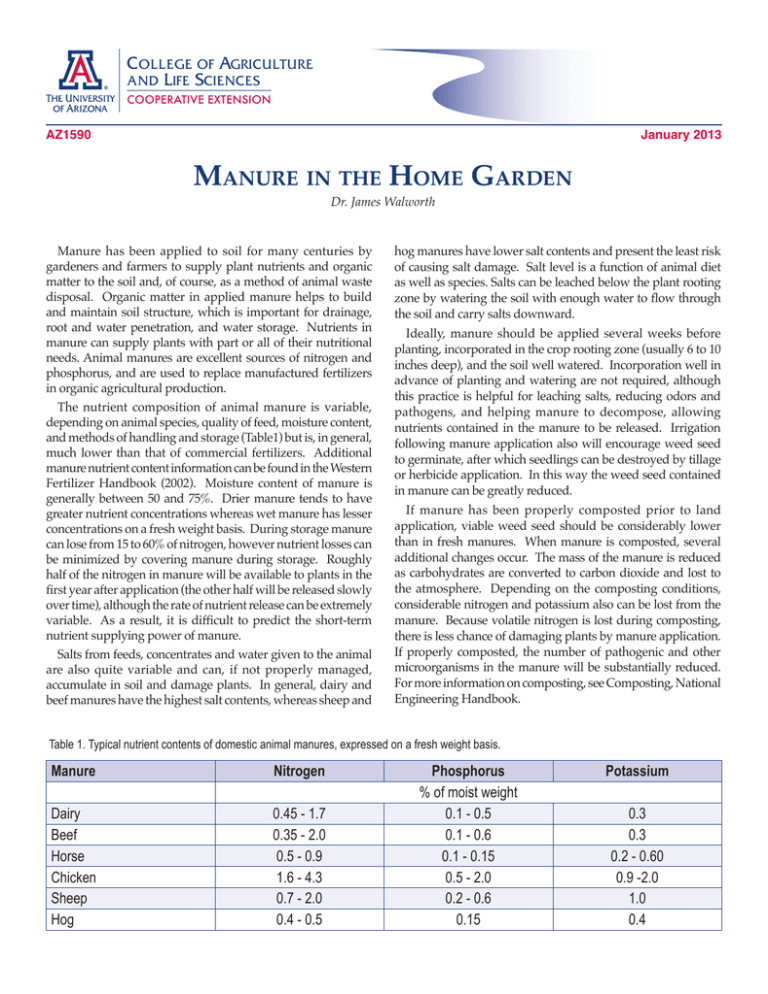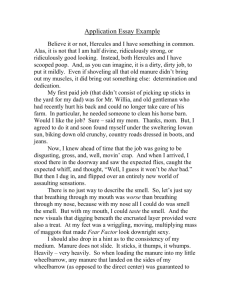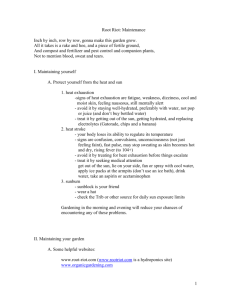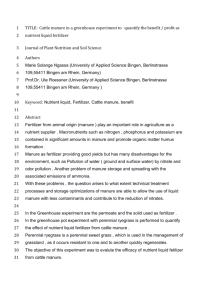M h G
advertisement

C OLLEGE OF AGRICULTURE AND LIFE SCIENCES COOPERATIVE EXTENSION AZ1590 January 2013 Manure in the Home Garden Dr. James Walworth Manure has been applied to soil for many centuries by gardeners and farmers to supply plant nutrients and organic matter to the soil and, of course, as a method of animal waste disposal. Organic matter in applied manure helps to build and maintain soil structure, which is important for drainage, root and water penetration, and water storage. Nutrients in manure can supply plants with part or all of their nutritional needs. Animal manures are excellent sources of nitrogen and phosphorus, and are used to replace manufactured fertilizers in organic agricultural production. The nutrient composition of animal manure is variable, depending on animal species, quality of feed, moisture content, and methods of handling and storage (Table1) but is, in general, much lower than that of commercial fertilizers. Additional manure nutrient content information can be found in the Western Fertilizer Handbook (2002). Moisture content of manure is generally between 50 and 75%. Drier manure tends to have greater nutrient concentrations whereas wet manure has lesser concentrations on a fresh weight basis. During storage manure can lose from 15 to 60% of nitrogen, however nutrient losses can be minimized by covering manure during storage. Roughly half of the nitrogen in manure will be available to plants in the first year after application (the other half will be released slowly over time), although the rate of nutrient release can be extremely variable. As a result, it is difficult to predict the short-term nutrient supplying power of manure. Salts from feeds, concentrates and water given to the animal are also quite variable and can, if not properly managed, accumulate in soil and damage plants. In general, dairy and beef manures have the highest salt contents, whereas sheep and hog manures have lower salt contents and present the least risk of causing salt damage. Salt level is a function of animal diet as well as species. Salts can be leached below the plant rooting zone by watering the soil with enough water to flow through the soil and carry salts downward. Ideally, manure should be applied several weeks before planting, incorporated in the crop rooting zone (usually 6 to 10 inches deep), and the soil well watered. Incorporation well in advance of planting and watering are not required, although this practice is helpful for leaching salts, reducing odors and pathogens, and helping manure to decompose, allowing nutrients contained in the manure to be released. Irrigation following manure application also will encourage weed seed to germinate, after which seedlings can be destroyed by tillage or herbicide application. In this way the weed seed contained in manure can be greatly reduced. If manure has been properly composted prior to land application, viable weed seed should be considerably lower than in fresh manures. When manure is composted, several additional changes occur. The mass of the manure is reduced as carbohydrates are converted to carbon dioxide and lost to the atmosphere. Depending on the composting conditions, considerable nitrogen and potassium also can be lost from the manure. Because volatile nitrogen is lost during composting, there is less chance of damaging plants by manure application. If properly composted, the number of pathogenic and other microorganisms in the manure will be substantially reduced. For more information on composting, see Composting, National Engineering Handbook. Table 1. Typical nutrient contents of domestic animal manures, expressed on a fresh weight basis. Manure Nitrogen Dairy Beef Horse Chicken Sheep Hog 0.45 - 1.7 0.35 - 2.0 0.5 - 0.9 1.6 - 4.3 0.7 - 2.0 0.4 - 0.5 Phosphorus % of moist weight 0.1 - 0.5 0.1 - 0.6 0.1 - 0.15 0.5 - 2.0 0.2 - 0.6 0.15 Potassium 0.3 0.3 0.2 - 0.60 0.9 -2.0 1.0 0.4 Table 2. Maximum amounts of animal manure to apply to soil. Manure Dairy Maximum amount to add (lbs/square foot/year) 1 Beef 1 Horse 1¼ Chicken 1 /3 Sheep 2 /3 Hog 2 The optimum amount of manure to be applied varies depending on its composition. Manure application often is calculated on the basis of its nitrogen content such that enough manure is added to provide the nitrogen for growing plants. For example, if 200 lbs of available nitrogen per acre is required (a typical value for many vegetables), then about 400 lbs of total nitrogen per acre each year should be added (based on the assumption that about 50% of the nitrogen will become available in the first year). Thus a typical steer or dairy cow manure containing approximately 1% nitrogen can be applied each year at a rate of 20 tons per acre (40,000 lbs/acre x 0.01 lbs nitrogen/lb of manure = 400 lbs of total nitrogen). One acre is 43,560 square feet, so this is equivalent to about 1 pound manure per square foot of soil. Approximate maximum application rates are given in Table 2, but will vary depending on manure composition. Manure applied at these rates should supply enough nutrients for most growing plants. However, if large quantities of leaching water are applied nitrogen may be leached out of the rooting zone, and additional nitrogen fertilizer may be required. Phosphorus and other nutrients contained in applied manure are less likely to be lost, and the manure rates listed above should supply an adequate nutrient supply. Application of manure in amounts greater than these may result in damage to growing plants, primarily through excessive nitrogen and salt levels. Irrigate the soil after incorporating manure with at least 4 inches of water. This will wet the soil to approximately 2 to 4 feet, carrying soluble salts beyond the crop rooting zone, and helping to break down manure as noted earlier. Excessive soluble salts can result in poor seed germination, stunted growth, and a burned appearance on growing plants. Leaves will first appear yellow, then brown around the margins or edges, usually beginning at the tips and then progressing toward the base. Leaves may eventually turn brown and die. If these symptoms occur, additional water should be applied to leach salts below the rooting area. Some animal manures have considerable levels of sodium, which can cause degradation of soil physical properties over time. If water penetration problems are noticed 1 to 2 tons/ acre or 50 to 100 lbs of gypsum/1000 square feet can be added along with annual manure applications. See Using Gypsum and Other Calcium Amendments in Southwestern Soils for more information on use of gypsum. Animal manures supply plant nutrients and can supplement or replace manufactured fertilizers. Manure also adds organic matter to the soil. Even in desert soils, where organic matter decomposes quickly, addition of manure helps to build and maintain soil structure, improving soil drainage, root and water penetration, and water storage. And lastly, applying manure to soil is a responsible, efficient way of disposing of animal wastes. References USDA NRCS. 2000. Chapter 2 Composting. Part 637 Environmental Engineering National Engineering Handbook. United States Department of Agriculture. Western Fertilizer Handbook, Ninth Edition. 2002. California Plant Health Association Walworth, J.L. 2012. Using Gypsum and Other Calcium Amendments in Southwestern Soils. Publication AZ1413, College of Agriculture and Life Sciences, University of Arizona. C OLLEGE OF AGRICULTURE AND LIFE SCIENCES COOPERATIVE EXTENSION The University of Arizona College of Agriculture and Life Sciences Tucson, Arizona 85721 James Walworth Ph.D. Professor And Extension Specialist, Soil Science Department Of Soil, Water And Environmental Science Contact: James Walworth walworth@cals.arizona.edu This information has been reviewed by University faculty. cals.arizona.edu/pubs/garden/az1590.pdf Other titles from Arizona Cooperative Extension can be found at: cals.arizona.edu/pubs Any products, services or organizations that are mentioned, shown or indirectly implied in this publication do not imply endorsement by The University of Arizona. Issued in furtherance of Cooperative Extension work, acts of May 8 and June 30, 1914, in cooperation with the U.S. Department of Agriculture, Jeffrey C. Silvertooth, Associate Dean & Director, Economic Development & Extension, College of Agriculture and Life Sciences, The University of Arizona. The University of Arizona is an equal opportunity, affirmative action institution. The University does not discriminate on the basis of race, color, religion, sex, national origin, age, disability, veteran status, or sexual orientation in its programs and activities. 2 The University of Arizona Cooperative Extension






